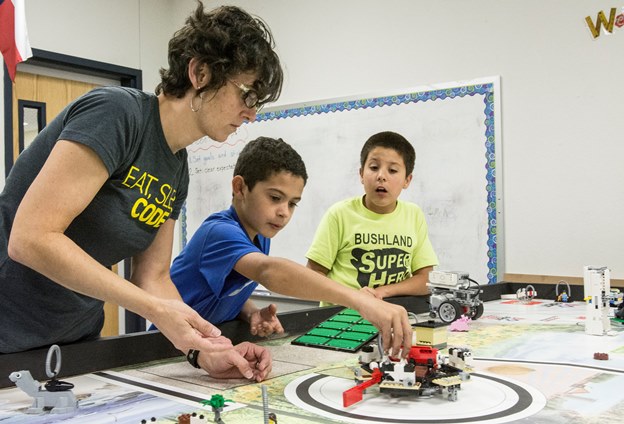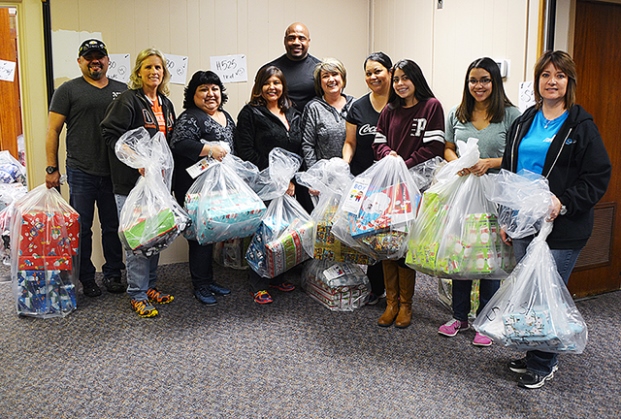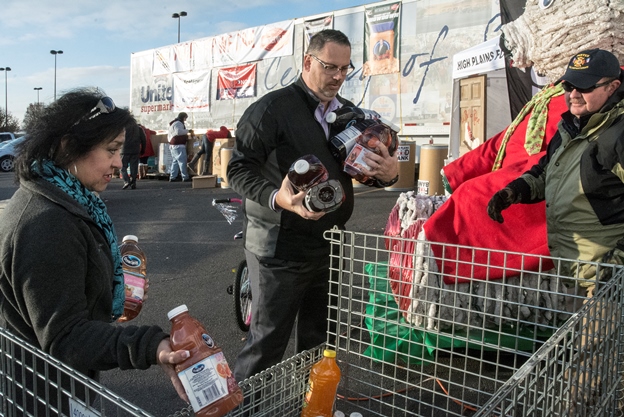Pantex Blog
Historical Pantex: A village is born
In 1943, housing was at a premium in the Amarillo area. With the war effort and production at Pantex already in full swing and a growing workforce, the need for new homes was obvious.

Construction of pre-fab housing units at the Pantex Village.
The National Housing Administration approved 175 new homes to be built in Amarillo for Pantex employees with 3 or more family members, but even that number was not sufficient. So, an additional 360 units were approved including 142 two-room apartments, 128 one-bedroom apartments, 60 two-bedroom units and 30 with three bedrooms.
It was all part of what was then called “Pantex City,” which was located just north of U.S. Highway 60 and Farm-to-Market Road 683. Initially, along with apartment buildings and homes, plans for the city included a shopping center with a grocery store, meat market, fire station, drug store, barber shop, beauty parlor, shoe repair and a tailor shop. There was also talk of a possible grade school with plans to bus students back to town for high school.
Construction was slated for completion in April 1943, thanks to pre-fabricated, mass-production methods. The apartment buildings went up like Tinker Toys with each dwelling having between four to eight apartments. An additional 400 pre-fab homes were soon added, bringing the population of the Pantex Village up to a few thousand. The village grew to 69 residence buildings, a community center and a store to support the approximately 5,325 employees at Pantex working 3 shifts at the height of World War II.
Noted cowboy poet and author Buck Ramsey lived at the village, according to a 1977 article called “Letter from the Panhandle,” which was printed in the Texas Observer magazine. In it, he reminisced about his time at Pantex.
“On the western edge, the government constructed a village; symmetrical rows of buildings so uniform there was a nightly problem of entering the wrong apartment by mistake. The war industry, with its promise of regular paychecks and dwellings with gas heaters and indoor plumbing, lured many families from the hardscrabble countryside. Mine was among them.
“I sometimes slipped through the fences to wander about the forbidden pastures, to lie on my back in the ungrazed grass… and listen to trains rumble away with bombs for Europe and Asia. The war ended with me seven years old. For a couple more years we lived in the village, while the munitions plant deteriorated from the peace. I grew bolder with age and would climb up to survey the area from watchtowers. I walked the barracks porches, and then broke into deserted buildings to steel my nerves against the ghosts inside, preparing myself for some future war.”
Ramsey noted in his writings about the barren countryside and how set apart the village seemed to be from the rest of the area.
In fact, the village was very isolated, functioning as a self-sufficient community. It was 10 miles from the town of Panhandle and accessed only through a perimeter gate that was locked each evening. There were recreational facilities, especially for the younger set, including basketball and tennis courts along with a teen club where dances took place.
To some outsiders, the village was known as the low-income “Cardboard Village” due to the pre-fab materials and walls so thin you could hear neighbors talking.
As a village, there was also a small newspaper called the Pantex Breeze. There were no real village officials because the place was run like a housing project. There was a manager, but no one was ever elected as an official to preside over the village.
After the war, things started to change. In 1949, the plant and village were acquired by Texas Technological College (now Texas Tech University) in Lubbock, and, by the end of that year, the village was turned over to Carson County.
The village was still going strong in the early 1950s. According to housing advertisements in the Pantexan magazine, the rent for a one- to three-bedroom apartment ranged from $33 to $42 per month, with all utilities paid.
In 1968, Pantex Village closed due to the large number of vacancies caused by improved economic opportunities elsewhere and the closing of the Amarillo Air Base in 1967.
Eventually, ads were placed throughout the Panhandle that the buildings were all to be sold at auction. Some of the smaller buildings are reportedly still being used in the town of Panhandle as a storage shed and another as a re-bricked building. Today, all that’s left as a reminder of the early days of the facility and the role it played at the Pantex Plant are a few concrete slabs dotted around the area where the village once stood.
However, the most surprising remnant of the auction is right down Interstate 40 as you enter Amarillo. On the east side of town, you will find one of the most advertised and well visited tourist destinations, the Big Texan Steak Restaurant, famous for its “free 72-ounce steak, if eaten within an hour.”
Bob Lee purchased and dismantled five barracks picked up at the auction and used the lumber to build his restaurant in 1960. Reportedly, most of that wood was lost in a fire in 1976, but the restaurant was rebuilt with the help of 100 of his employees pitching in.
Just like a time more than 30 years earlier… it took a village.
Smart Play
With nearly three-fourths of the workforce at the Pantex Plant only five years away from retirement age, Consolidated Nuclear Security (CNS) has put a heavy focus cultivating our future workforce.
Data from the U.S. Bureau of Labor Statistics (BLS) states that employment in occupations related to STEM – science, technology, engineering, and mathematics – is projected to grow to more than 9 million between 2012 to 2022. Something that we know first-hand.
In 2015, CNS donated $10,000 to Bushland Independent School District (BISD) to help them kick-start an initiative to create a hands-on, high-tech STEM educational program.
The district knew there was a need to provide more STEM-related education. They decided that the best direction to implement this initiative was to form elementary, middle, and high school teams that would participate in FIRST® (For Inspiration and Recognition of Science and Technology), international robotics competitions that drive students to research and explore real-world scientific and engineering challenges.

The teachers responsible for building this multi-level robotics program agreed upon a plan that no one saw coming. The popular choice would have been to use the funds to immediately support the high school STEM program, but the teachers chose to take a different approach. One that would build a solid foundation for STEM education for years to come.
“Just like in sports. You don’t wait until high school to start building athletes,” said BISD teacher and robotics sponsor, Jessica Patterson. “The same is true for education. You don’t wait until college to build engineers.”
Jessica Patterson, who runs Bushland Elementary’s Einstein Lab, along with Melissa Cochran, who handles the computer lab, and Christina Butler, who teaches special education, have other daily responsibilities but were willing to devote nights and weekends to cultivate a program that would enhance students’ learning to the next level.
After hosting a “Get to Know Robotics Family Night,” students organized teams to create their own robot and research presentation. By May 2015, BISD had 11 FIRST LEGO® League Jr. (JrFLL) teams, seven FIRST LEGO League (FLL) teams, and one FIRST Tech Challenge (FTC) team. The question now was: How can we serve more than 100 students without sending every one of them to Dallas to compete in a tournament?
Thus began the TexPan Robotics tournament. BISD staff, in conjunction with Amarillo College Engineering Society and Amarillo Area Center for Advanced Learning (AACAL), created a robotics tournament to serve all local teams.
“We saw the need for all students in the Texas Panhandle to have a local tournament to compete and celebrate learning,” said Patterson.
Currently, TexPan robotics is working with FIRST to become an official region for students in the panhandle. The 2015 tournament champions were The Purple Perspicacious Pandas, a group of six middle school girls who defeated their competitors to receive an ACE (Advancing to Championship) certificate allowing them to travel to Dallas to compete in the North Texas FLL Regional Championship in February 2016.
After tournament season ended, the Bushland Robotics teachers (otherwise known as the LEGO Ladies) devised a plan to rollout a “WE Do STEM” and EV3 robotics academy. The “WeDo STEM” academy serves students in kindergarten through second grade, and EV3 academy serves third through eighth grade. This six-week robotics academy was held outside of normal school hours and began teaching the basic skills of building and programing a robot. Later, academies addressed programming sensors and precision programming.
“We chose to keep to six-week learning programs because the short learning process engages kids to learn rather than just show up for a club meeting,” explained Patterson.
The academy was full within a matter of minutes of registration opening, showing the teachers that there was obviously an interest by the students and it was backed by their parents. The spring academies sparked such an interest in the students and their parents, that BISD now has seen a growth in teams to 11 JrFLL, 10 FLL, and two FTC teams. An outside interest has added two additional FLL teams from the local homeschool community and from the Boy Scout council.
“Without the donation from Pantex, this program would not have been possible,” said Patterson. “The students’ learning is so rapid that we are moving faster than we could have imagined and these resources provided by Pantex are an essential part to our success.”
Pantex provided BISD with another $10,000 contribution for the 2016–2017 school year in an effort for them to expand their program to the FTC for 7–12 grade students and eventually a FIRST Robotics Challenge team for 10–12 grade students.
Wild Pantex – Bird of the Day: The Curve-Billed Thrasher
Article by Jim Ray, Pantex Wildlife Biologist/Scientist
In recent years there has been “a new bird on the block” and I find it interesting that I keep catching them in traps set for skunks, feral cats and other critters. It appears that Curve-Billed Thrashers enter the traps just because they like to explore tight spaces. I also observe them going in and out of spaces under porches, in wooden and steel pallets, in bird houses, and in other tight quarters. Perhaps they are looking for spiders and paper wasps, and other creatures that like structure and darker places.

I have chosen the Curve-Billed Thrasher as bird of the day #4. Compared to the previous three “honorees,” the American Bald Eagle, Cliff Swallow, and Dickcissel, the curve-bill will be a new introduction to most of you. However, once clued in here, Pantex employees will notice this songbird throughout the working areas of our facility.
The Curve-Billed Thrasher is one that I became familiar with while growing-up in my hometown of Dalhart, Texas. A pair of curve-bills nested each summer for several years in a large cholla cactus in the backyard of my next door neighbor. I would monitor these nests closely from nest-building through fledging. Through the years, I developed the habit of looking around for a cholla cactus whenever I noticed a curve-bill …and, sure enough, there was usually one nearby. Knowing how cholla feels when I have brushed up against it, I always figured that the bird had an excellent plant to associate with when it came to selecting a place to nest.
Curve-Billed Thrashers are a southwestern bird, occurring in the western half of Texas, the Oklahoma Panhandle, and southwesterly including southern portions of New Mexico and Arizona, and down through the northern half of Mexico. It is related to the more common Northern Mockingbird, looks somewhat like it, except for a longer, more curved bill, and even sounds similar to it, except the thrasher’s voice is more “muffled” than the mockingbirds. It also lacks the characteristic white wing patches of the mockingbird. The juvenile curve-bills’ beaks are straighter than the older birds until they reach their second year of age. These birds spend less time leaping into the air than the mockingbird and more time running and pecking, and plucking insects and other invertebrates from vegetation, and the surfaces under or on man-made structures.
During my first five years of my working at Pantex, our staff did not observe a single Curve-Billed Thrasher, and I really would not have expected to observe many since we do not have any big, mature cholla cacti on site. However, I finally observed one at Pantex in 2004. Out of curiosity, I looked at the U. S. Geological Survey’s Breeding Bird Survey Data for curve-bills and found that major population increases have occurred here in the shortgrass prairie, especially since 2002. These thrashers have a major presence at my home, too, showing daily interest in my Purple Martin houses and my honey bees.
Keep an eye out for Curve-billed Thrashers around our buildings and at home. They are quite conspicuous (activity and sound) and you will find them to be quite abundant and entertaining. They are one of the few songbirds that stay paired and together over the entire year – consequently, you may see both members of the pair. Curve-billed Thrashers are certainly an interesting member of our Wild Pantex.
Pantexans support Christmas Project
The Pantex Christmas Project started in the late 1950s, and although it has gone by a few different names and has assisted needy families in various ways, one thing has remained the same: Pantexans’ desire to help others.

The project started when employees at Pantex thought they could pool the money they would normally use for buying each other gifts and instead buy toys, food, and clothing for families who would otherwise go without. Unlike other angel tree programs, Pantexans have the opportunity to adopt elderly as well as children.
“This year we worked with Family Support Services to help bring Christmas to those who might not otherwise get anything,” said Lennet Hernandez of Pantex Safeguards and Security. “Often the children have been uprooted from violent homes and usually do not get to bring anything with them. They are frightened, traumatized, and sometimes have been abused. We want to provide a great Christmas for them; for many it’s the first peaceful holiday they have ever experienced.”
The giving tradition continues; this year all 221 angels were adopted in less than 36 hours. Once an angel is selected, the fun begins. Take for example General Stores in Building 16‑19; they found a way to raise money for the gifts and have some fun at the same time.
“We had a pumpkin carving contest, a hot sauce taste off, breakfast casserole cook off, and an ugly sweater contest,” said Trey Gillman, a Pantex operations manager. “While these events are always full of cheerfulness and the spirit of giving, they can get very competitive as well.”
The idea of having fun events to raise money came last year, and it was so successful that this year they were able to raise $700 and adopt six angels.
“Whether it be an elderly person in a nursing home with no family to spend the holiday with, or a child whose parents are unable to provide gifts, we are fortunate enough to work at Pantex and be in a position to help these people out,” Gillman said.
Whether Pantexans bought a gift for a child or a nursing home resident, one thing is certain: Those gifts will bring a smile to many faces this holiday season.
Pantexans brave the cold at December food drive
For 22 years, the High Plains Food Bank has asked the community to help in the fight to alleviate hunger during the holidays by hosting their Together We Can food drive, and Consolidated Nuclear Security’s Pantex Plant was happy to help.

Pantexans braved the cold weather to man the food drive collecting donations – food and cash – from donors and sorting donations into appropriate bins.
“We at Pantex are so blessed with what we have and knowing that the food bank is going to help feed people in our community made me feel good to volunteer,” said Ester Sosa, with Pantex Enterprise Planning and Controls.
Pantex, along with other corporate sponsors and community members, helped the High Plains Food Bank bring in 730,477 meals through a combination of funds and non-perishable food items.
“We simply could not execute a successful holiday food and fund drive without our Sponsors of the Day, including our long-time partner, Pantex,” shared Emily Bell, communications and marketing manager for the High Plains Food Bank.
The High Plains Food Bank distributes about 625,000 meals – more than 700,000 pounds of food – each month to more than 170 feeding partner agencies who in turn serve between 8,000 and 9,000 families each month. Recently, that service number has risen to over 9,500 families throughout the Texas Panhandle.
